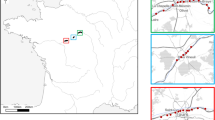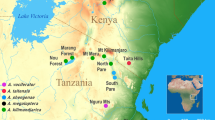Abstract
BOTANISTS have postulated polyploidy as an adaptation to cold; but it has been shown that in ferns polyploids occur more frequently in Ceylon than in western Europe1. Little or no geographical analysis has been attempted of the occurrence of atypical caryotypes in insects outside the genus Drosophila, although in the shieldbug genus Thyanta three neo-tropical species have 2n = 14 while three Nearctic species have 2n = 16, 16 and 27 respectively2.
This is a preview of subscription content, access via your institution
Access options
Subscribe to this journal
Receive 51 print issues and online access
$199.00 per year
only $3.90 per issue
Buy this article
- Purchase on Springer Link
- Instant access to full article PDF
Prices may be subject to local taxes which are calculated during checkout
Similar content being viewed by others
References
Manton, I., Symp. Soc. Exp. Biol., 7, 174 (1953).
Schrader, F., and Hughes-Schrader, S., Chromosoma, 7, 469 (1956).
Author information
Authors and Affiliations
Rights and permissions
About this article
Cite this article
LESTON, D. Geographical Zonation of Atypical Caryotypes in Shieldbugs. Nature 178, 933–934 (1956). https://doi.org/10.1038/178933b0
Issue Date:
DOI: https://doi.org/10.1038/178933b0
This article is cited by
-
Cyto-taxonomy of Miridae and Nabidae (Hemiptera)
Chromosoma (1956)
Comments
By submitting a comment you agree to abide by our Terms and Community Guidelines. If you find something abusive or that does not comply with our terms or guidelines please flag it as inappropriate.



